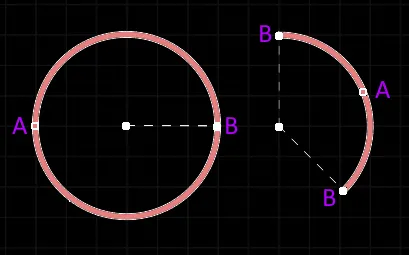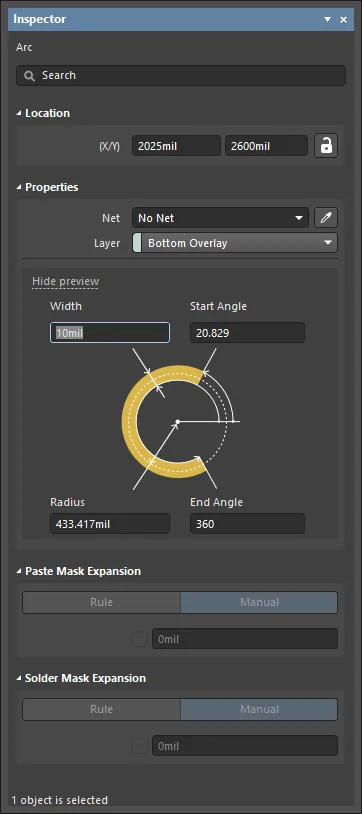Arcs and full circles are available for placement in both the PCB and PCB library editors.
- In the PCB editor:
- Choose Home | Place | Arc from the main menus then select the required placement mode from the sub-menu.

- Choose Home | Place | Full Circle from the main menus to place a full circle.

- In the PCB library editor:
- Choose Home | Place | Arc from the main menus then select the required arc mode or Full Circle from the sub-menu.

-
Right-click in the design space then choose Place » Arc (Center), Arc (Edge), Arc (Any Angle), or Full Circle.
The way in which an arc is placed depends on the particular method of placement that you have chosen to invoke. Four different methods of arc placement are supported:
- Arc (Center) – this method enables you to place an arc object using the arc center as the starting point.
- Arc (Edge) – this method enables you to place an arc object using the edge of the arc as the starting point. The arc angle is fixed at 90°.
- Arc (Any Angle) – this method enables you to place an arc object using the edge of the arc as the starting point. The angle of the arc can be any value.
- Full Circle – this method enables you to place a 360° (full circle) arc.
Placing an Arc Starting at the Center
After launching the command, the cursor will change to a cross-hair and you will enter arc placement mode. Placement is made by performing the following sequence of actions:
- Click or press Enter to anchor the center point of the arc.
- Move the cursor to adjust the radius of the arc then click or press Enter to set it.
- Move the cursor to adjust the start point for the arc then click or press Enter to anchor it.
- Move the cursor to change the position of the arc's endpoint then click or press Enter to anchor it and complete placement of the arc.
- Continue placing further arcs or right-click or press Esc to exit placement mode.
Placing an Arc Starting at the Edge
After launching the command, the cursor will change to a cross-hair and you will enter arc placement mode. Placement is made by performing the following sequence of actions:
- Click or press Enter to anchor the start point for the arc.
- Move the cursor to change the position of the arc's endpoint then click or press Enter to anchor it and complete placement of the arc.
- Continue placing further arcs or right-click or press Esc to exit placement mode.
Placing an Arc Starting at the Edge (any angle)
After launching the command, the cursor will change to a cross-hair and you will enter arc placement mode. Placement is made by performing the following sequence of actions:
- Click or press Enter to anchor the start point for the arc.
- Move the cursor to adjust the radius of the arc then click or press Enter to anchor the center point.
- Move the cursor to change the position of the arc's endpoint then click or press Enter to anchor it and complete placement of the arc.
- Continue placing further arcs or right-click or press Esc to exit placement mode.
Placing a Full Circle
After launching the command, the cursor will change to a crosshair and you will enter arc placement mode. Placement is made by performing the following sequence of actions:
- Click or press Enter to anchor the center point of the circle.
- Move the cursor to adjust the radius of the circle then click or press Enter to set it and complete placement of the circle.
- Continue placing further circles or right-click or press Esc to exit placement mode.
Additional Placement Actions
Additional actions that can be performed during placement are:
- For all methods (except full circles), press the Spacebar before defining the arc's endpoint to render the arc in the opposite direction.
- Press the L key to flip the arc to the other side of the board. Note that this is only possible prior to anchoring the arc's start/center point.
- Press the + and - keys (on the numeric keypad) or use the Shift+Ctrl+Wheelroll shortcuts to cycle forward and backward through all visible layers in the design to change the placement layer quickly.
- Press the Tab key to open the Arc mode of the Inspector panel in which properties for the arc can be changed on-the-fly. When this is done, interactive editing will pause so that the panel can be used, click the pause button (
 ) that appears in the center of the design space to return to the interactive arc placement mode or press Esc.
) that appears in the center of the design space to return to the interactive arc placement mode or press Esc.
Graphical Editing
This method of editing allows you to select a placed arc/full circle object directly in the design space and graphically change its size, shape or location.
When an arc/full circle object is selected, the following editing handles are available:

- Click and drag A to adjust the radius.
- Click and drag B to adjust the endpoints (start and end angles).
- Click anywhere on the arc/full circle away from editing handles then drag to reposition it. Alternatively, click and drag on the arc/full circle center point. While dragging, the arc/full circle can be rotated or mirrored:
- Press the Spacebar to rotate the arc counterclockwise or Shift+Spacebar for clockwise rotation. Rotation is in accordance with the value for the Rotation Step, defined on the PCB Editor – General page of the System Preferences.
- Press the X or Y keys to mirror the arc along the X-axis or Y-axis.
To clear the selection of (or de-select) the object, use the Esc key.
Non-Graphical Editing
This method of editing uses the Inspector panel to modify the properties of an Arc object.

During placement, the Arc mode of the Inspector panel can be accessed by pressing the Tab key. Once the Arc is placed, all options appear.
After placement, the Arc mode of the Inspector panel can be accessed in one of the following ways:
- If the Inspector panel is already open, select the Arc object.
- With the arc selected, choose View | PCB | Inspector from the main menus.
Press Ctrl+Q to toggle the units of measurement currently used in the panel between metric (mm) and imperial (mil). This only affects the display of measurements in the panel; it does not change the measurement unit specified for the board, which is configured in the Units setting in the Inspector panel when there are no objects selected in the editing design space.